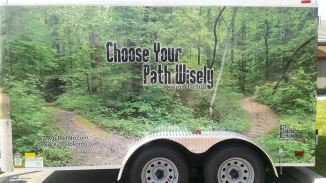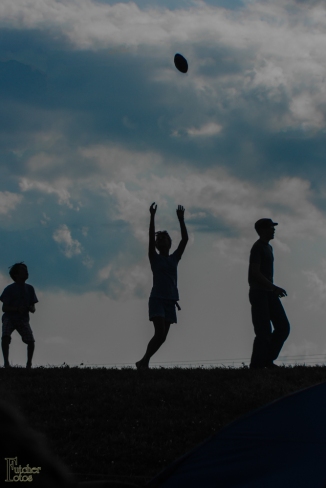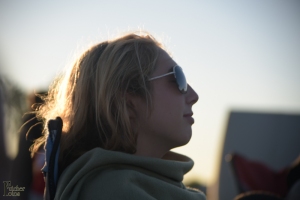This is another picture from our week at the Oshkosh Pathfinder Camporee. When the kids had free time, they enjoyed playing on this hill right by our campsite–which also happened to be a great location for pictures. When the kids started tossing the football, we decided we wanted to catch it in the air. To accomplish this, we teamed up. I watched for when the ball would be thrown and indicated that timing to Rob, who had his eye to the viewfinder and finger on the trigger ready to catch this moment.
When the Sun Shines
We just returned from a week of camping with about 37,000 young people. And though we were greeted with mud (our bus got stuck on the way to the campsite) and left in a downpour, the days in-between were nice.
Rob was shooting pictures from morning ’til night for a souvenir book we’ll be putting together. It was fun to see how he worked with the different lighting throughout the day.
Among my favorite photos, are these pictures Rob took during the evening meeting when he noticed that the setting sun was creating a golden shimmer in one of our young people’s hair.
A Trailer with a Message
 Right now, more than 36,000 young people from more than 60 countries are making their way to the Forever Faithful Pathfinder Camporee in Wisconsin. One of the clubs attending is pulling along this trailer, featuring one of Rob’s photographs. If you’re going to be there, look for it. If you can tell us which club this is, we will give you a 10 percent discount on any purchase.
Right now, more than 36,000 young people from more than 60 countries are making their way to the Forever Faithful Pathfinder Camporee in Wisconsin. One of the clubs attending is pulling along this trailer, featuring one of Rob’s photographs. If you’re going to be there, look for it. If you can tell us which club this is, we will give you a 10 percent discount on any purchase.
The In-Between Story
If you haven’t already listened to the Photography Tips HQ podcast featuring Futcher Fotos, check it out here: pthq-podcast-episode-13
Interviewing for this podcast was both exciting and nerve-wracking. And, of course, as soon as the interview was over, our minds were filled with things we should have said. Nevertheless, listening to it again several weeks after the actual interview, I found myself becoming re-inspired as we move forward with our business ventures.
In this blog, however, I’d like to share a bit of the in-between story that I left out as I was being asked about my photography background. The story I told in the interview took me straight from having a less-than-successful photography class experience to helping my husband start a photography business. There’s more than 20 years in between those two parts of the story, and I did have a couple experiences during that time that encouraged me in the direction of photography. As Paul Harvey would say, here is the rest of the story.
After graduating from college, I went to work in the communication department of the Seventh-day Adventist Church World Headquarters, in a building that housed more than 800 employees. Shortly after joining (when I still barely knew anybody), I was asked if I wanted to photograph the employee picnic. Not being particularly comfortable mingling with strangers but still wanting to attend and have a chance to get to know people, I was happy to have a role that would keep me occupied without feeling socially awkward.
I particularly enjoyed photographing the kids at the picnic, and when the pictures were developed, there were a couple pictures I chose for the employee newsletter. One was of a girl jumping through a puddle, and the other–which I particularly loved–was of two sisters with balloon hats eating cotton candy with the help of their grandmother. The picture was so colorful that I almost hated using it in a black-and-white publication. Nevertheless, I ran both of those pictures and got some nice feedback–particularly from one coworker who felt I should enter them in a photography contest. Still feeling I was an inadequate photographer after my class experience, I shrugged that compliment off–but it did help me gain more confidence as I continued taking pictures as part of my job.
By the way, those two girls with the balloon hats ended up being flower girls in my wedding. I hadn’t met my husband yet, but these were children of one of his best friends.
Leaving that position, I worked for several years in jobs where I didn’t have to think about photography, except maybe to hire a photographer here and there. Then in my most recent job, I was an editor for a university alumni magazine. Student photographers took most of the photos that went into our magazines, and I found myself having very specific ideas of how the photos should turn out–so specific that I when I could I started accompanying the photographers on their photo shoots so I could direct them. Little did I know this role would be a big part of the next phase of my career.
While Rob is the one who’s usually behind the camera in our business, I’m often to the side, posing subjects and giving feedback. It’s a good fit for me. I’m not as comfortable with the technical side of taking pictures–but Rob’s got that part covered. But I love directing people (I was a drama director for several years), and I love being a part of creating the picture.
And so, despite having a difficult Intro to Photography (that was literally the name of the class), it turns out that life experience gave me my niche in this field.
Like Father, Like Son
 This week, the boys in our family are attending a media camp at one of the local universities. It’s great to see my son crouching down on the floor and positioning himself to get the perfect shot–just like a real photographer.
This week, the boys in our family are attending a media camp at one of the local universities. It’s great to see my son crouching down on the floor and positioning himself to get the perfect shot–just like a real photographer.
Though photography isn’t his number one passion, he has been showing more interest in it lately. In fact, he’s the one that took the picture of our new camera in my last blog. I love seeing him enjoy something that has brought joy to several generations of our family.
Our New Nikon
Today is the day Rob has been waiting for. Our new Nikon D810 arrived.
While any photographer will tell you that it’s the photographer not the gear that makes a great picture, they’ll also tell you that great gear certainly helps. Here are some ways that  our newest Nikon will help us provide you with a stellar photography experience.
our newest Nikon will help us provide you with a stellar photography experience.
1. Less distraction Because this camera operates nicely in low-light situations, we’ll be able to leave the flash off at times where it would be distracting. A quieter shutter will also mean less distraction when taking pictures in classrooms and other “inside voice” locations.
2. What we see is what you get. In many cameras, the view finder doesn’t match exactly what is going to be in the final picture. This means, distracting elements can creep into the photo without the photographer being aware. Though these elements can always be cropped out later, this takes time and reduces the final size of the picture. By being able to take the picture exactly right the first time, we can streamline our editing so that we can take on more projects. And you’ll be able to order very large prints without interfering with the picture quality.
3. No more pictures with Uncle Bob’s eyes closed. There aren’t many things more frustrating to a photographer than thinking you have a great picture, then loading your images onto your computer and realizing someone has their eyes closed or is looking off to the side. To prevent this, we’ve followed the rule of always taking three pictures of each pose to make sure at least one turns out. Even then we recently had to use Photoshop to “open” someone’s eyes in a recent group photo. This camera has a larger, sharper screen that allows you to get a preview of the image that’s nearly as detailed as what you’ll be able to see on the computer.
Choose Your Path Wisely

Ally and the Shrew
 Meet Ally. She’s an indoor cat, but every morning she joins the family for an hour of garden time.
Meet Ally. She’s an indoor cat, but every morning she joins the family for an hour of garden time.
This time of outdoor adventure is one of the ways we make sure our kids have regular exposure to nature. They’re expected to help in the garden for the first half hour then they’re allowed to have a half hour of “adventure time.” The only rule is they must stay outdoors (and no, that doesn’t mean bringing their digital devices outdoors).
When we started this several years ago, there was much whining and complaining, but soon creativity set in and they would go about the yard or garden pretending to be dinosaurs. These days there are few complaints and we’ve used this time to enjoy watching tadpoles, snakes, and turtles and tasting berries and honeysuckle.
Every morning, Ally and our dog, Jackson, sense when we are about to go out and get all jittery with excitement. This morning, I was ready to head out before the rest of the family and took a very enthusiastic Ally with me. Our garden is a fenced-in area within a fenced-in yard, and since she could easily get through any of the fences, we try to keep her with us. Often, though, she jumps out and explores the brush that lines our back fence just beyond the garden. When she does, we coax her back where we can keep a better eye on her.
dog, Jackson, sense when we are about to go out and get all jittery with excitement. This morning, I was ready to head out before the rest of the family and took a very enthusiastic Ally with me. Our garden is a fenced-in area within a fenced-in yard, and since she could easily get through any of the fences, we try to keep her with us. Often, though, she jumps out and explores the brush that lines our back fence just beyond the garden. When she does, we coax her back where we can keep a better eye on her.
This morning she was quick to jump out of the garden area. I stopped my weeding to pick her up and bring her back into the enclosure. Usually, she doesn’t even need to be picked up but the simple “threat” of being picked up will send her bounding back to the garden. Not today. Immediately after I put her back in the garden, she jumped right back out and headed back to the same s pot, burying her head in the brush.
pot, burying her head in the brush.
Once again, I grabbed her. And once again, she looked as though she were about to hop back out, so I stood guard for a bit. In a blatant attempt to stop my guarding behavior, she laid down as if she were going to relax. As soon as I stepped back into the garden, she was out again. At this point, my son was heading out. “I’ll take care of her,” he called out, so I went back to weeding as he made his way from the deck to the back of our yard. By this point, Ally was deep in the brush and my son commented on how hard she was to get out. Then suddenly, she turned and bounded into the garden–and in her mouth, there was a shrew!
We immediately sent a text to Rob, who was still finishing breakfast, and within moments he and Sierra, our daughter, had joined us. We spent most of our garden hour watching Ally play with her prey.
Not much weeding got done today, but the primary purpose of our outdoor hour was fulfilled. Our kids had an up-close-and-personal view of nature in action–predator and prey doing their thing. It was an entertaining, educational, bonding moment–and it didn’t cost us a thing!
Too often, I think, we miss moments like this because we’ve separated ourselves from the natural world. What are some things you can do to make sure your family is spending time out in nature on a regular basis?
Getting a Close-Up Look
 When Rob and I were dating, we started going on nature walks together. I would walk along briskly, getting a feel for the overall aura of the natural surroundings. Rob, on the other hand, would stop frequently, peering through his binoculars (which he kept in his car so he would always have them with him) at the wildlife I was missing.
When Rob and I were dating, we started going on nature walks together. I would walk along briskly, getting a feel for the overall aura of the natural surroundings. Rob, on the other hand, would stop frequently, peering through his binoculars (which he kept in his car so he would always have them with him) at the wildlife I was missing.
So it should come as no surprise that Rob has developed a knack for photographing those creations many of us miss in our hurried lives.
What amazes me most is that Rob does not use a macro lens. I asked him what the advantage of this was, and he mentioned that by not having to get as close to the wildlife as a macro lens would require, he’s able to get their picture without scaring them away.
 As we make a concentrated effort to get Rob’s view of the world out where others can enjoy it, one of our projects will be a photo book (or perhaps several) focusing specifically on the smaller beauties of the natural world.
As we make a concentrated effort to get Rob’s view of the world out where others can enjoy it, one of our projects will be a photo book (or perhaps several) focusing specifically on the smaller beauties of the natural world.
It has been our dream for years to do a book together. And it’s certainly a logical project for a photographer husband and writer wife to accomplish. Yet, until recently, that dream has seemed out of reach. (I know first-hand the soul-draining process of trying to get published traditionally.) With the skills we’ve been learning lately, we feel confident that we can successfully self-publish and market such a book. Meanwhile, the pictures he gathers for the book will also be made available for sale in other formats. If you’re interested in purchasing these or other photos, check out our online storefront.
Creating a Price That’s Right
With graduation and sports camp season over, our big push for the rest of the summer is getting some nature art products ready to market to retailers. To prepare for this, we watched Megan Auman’s CreativeLive class “Sell Your Products to Retailers.”
Like every class on CreativeLive, this class was an excellent. If you have any product you’re selling, whether or not you’re wanting to go retail, we highly recommend listening to what Megan has to say.
One of the most eye-opening segments of her class was about setting a price point. Up until now, we’ve been following the traditional materials x3 or x4 method that many enterperneurs start with. But for many reasons this pricing system wasn’t making sense. Some prices seemed too high in comparison with others, which were probably too low. And when it came right down to it, like nearly everyone in Megan’s class, we weren’t bringing in enough to pay ourselves a living wage–let alone make a profit. So one of the first things we’re going to tackle is re-examining our prices using Megan’s method.
There are four components to consider when setting prices this way: materials, labor, overhead, and profit. Add those all together, and you have your wholesale price. Multiply that number by at least two, and you have your retail price.
Let’s look at each of these elements individually.
These are any expendable goods used in your product. That’s the number we were multiplying by three or four. But as Megan said, “Your product is worth way more than the sum of materials.” So now we’ll just plug in the actual cost of materials into this new equation and move on.
 2. Labor If you’re creating the products you sell, you need to pay yourself a living wage. As obvious as that seems, that’s where many of us are failing. When figuring out your living wage, keep in mind that only about half your work time will be billable hours, so set a wage that’s double of what you really need to make per hour. Also, keep in mind that unlike most corporate jobs, you’re not getting benefits on top of your hourly wage, so you’re going to need to cover things like insurance and vacation time. Megan, who says she lives in a low cost-of-living area, pays herself $60 an hour. One thing that’s nice about this amount is that it breaks down to $1 per minute. So if a product takes you 12 minutes to make, you tack on $12 to the cost of your product.
2. Labor If you’re creating the products you sell, you need to pay yourself a living wage. As obvious as that seems, that’s where many of us are failing. When figuring out your living wage, keep in mind that only about half your work time will be billable hours, so set a wage that’s double of what you really need to make per hour. Also, keep in mind that unlike most corporate jobs, you’re not getting benefits on top of your hourly wage, so you’re going to need to cover things like insurance and vacation time. Megan, who says she lives in a low cost-of-living area, pays herself $60 an hour. One thing that’s nice about this amount is that it breaks down to $1 per minute. So if a product takes you 12 minutes to make, you tack on $12 to the cost of your product.
 3. Overhead This is probably going to be the most difficult thing for us to figure out the first time we price something using this new method. For overhead, you add up all your non-material business expenses from the past year (don’t forget your housing expenses if you work from home) and figure out what additional expenses you want to plan for the next year. Take that total amount and divide that by 12 to figure out your monthly overhead. Then figure out how many hours a month you spend creating products. Divide your monthly overhead by the number of hours you’ll be creating in order to come up with your “hourly burn.” Then for each product include the appropriate amount of hourly burn to include in the cost, depending on how long your product takes to make. (For example, if your product takes half-an-hour to make, you would include half of your “hourly burn” in the cost.
3. Overhead This is probably going to be the most difficult thing for us to figure out the first time we price something using this new method. For overhead, you add up all your non-material business expenses from the past year (don’t forget your housing expenses if you work from home) and figure out what additional expenses you want to plan for the next year. Take that total amount and divide that by 12 to figure out your monthly overhead. Then figure out how many hours a month you spend creating products. Divide your monthly overhead by the number of hours you’ll be creating in order to come up with your “hourly burn.” Then for each product include the appropriate amount of hourly burn to include in the cost, depending on how long your product takes to make. (For example, if your product takes half-an-hour to make, you would include half of your “hourly burn” in the cost.
 4. Profit This is the area where we leave the hard calculations. Up until this point, we’ve plugged in numbers to make sure we aren’t losing money. Here, rather than coming up with an amount that should be our profit, we’re going switch over to value-based pricing and determine the value of our product. One exercise Megan had us do in order to help determine our value was to conduct a Google search to see the highest priced item we could find in our general category. A very quick search for the term for “nature wall art” resulted in a piece being sold for $2,700. That’s not to say that we’re going to sell our work for $2,700 (at least not yet!), but I think that was to show us that there are people who are willing to pay that much for pieces in the same category ours. Megan’s suggestion is to not choose a price that’s middle of the road but to go for something higher than the middle, keeping in mind the mental price barriers that stores like to stay under ($25, $50, $100, $150, $200 etc.). Once you have the price for one item, line up your other items and select prices that make sense in relation to each other.
4. Profit This is the area where we leave the hard calculations. Up until this point, we’ve plugged in numbers to make sure we aren’t losing money. Here, rather than coming up with an amount that should be our profit, we’re going switch over to value-based pricing and determine the value of our product. One exercise Megan had us do in order to help determine our value was to conduct a Google search to see the highest priced item we could find in our general category. A very quick search for the term for “nature wall art” resulted in a piece being sold for $2,700. That’s not to say that we’re going to sell our work for $2,700 (at least not yet!), but I think that was to show us that there are people who are willing to pay that much for pieces in the same category ours. Megan’s suggestion is to not choose a price that’s middle of the road but to go for something higher than the middle, keeping in mind the mental price barriers that stores like to stay under ($25, $50, $100, $150, $200 etc.). Once you have the price for one item, line up your other items and select prices that make sense in relation to each other.
Although it’s going to be a lot of work to switch over to this type of pricing, I feel a lot better about it than what we’ve been doing. So what do you think? If you’re in business, what pricing model have you been using? Do you think you could switch over to this model?





